In this Post
"Often imitated, never duplicated"
Media Review:
Hunting With My Ancestors
Media Review:
The Canadian Inuit Dog:
Icon of Canada’s North
Navigating This Site
Index of articles by subject
Index of Journal editions by
volume number
Index of PostScript editions by
publication number
Search The Fan Hitch
Articles to download and print
Ordering Ken MacRury's Thesis
Our comprehensive list of resources
Defining the Inuit Dog
Talk to The Fan Hitch
Shop & Support Center
The Fan Hitch home page
Index of articles by subject
Index of Journal editions by
volume number
Index of PostScript editions by
publication number
Search The Fan Hitch
Articles to download and print
Ordering Ken MacRury's Thesis
Our comprehensive list of resources
Defining the Inuit Dog
Talk to The Fan Hitch
Shop & Support Center
The Fan Hitch home page
Editor's/Publisher's
Statement
Editor: Sue Hamilton
Webmaster: Mark Hamilton
The Fan Hitch Website and
Publications of the Inuit Sled Dog– the
quarterly Journal (retired
in 2018) and PostScript – are dedicated to the aboriginal
landrace traditional Inuit Sled Dog as well as
related Inuit culture and traditions.
PostScript is
published intermittently as
material becomes available. Online access is
free at: https://thefanhitch.org.
PostScript welcomes your
letters, stories, comments and suggestions.
The editorial staff reserves the right to
edit submissions used for publication.
Contents of The Fan Hitch Website and its publications are protected by international copyright laws. No photo, drawing or text may be reproduced in any form without written consent. Webmasters please note: written consent is necessary before linking this site to yours! Please forward requests to Sue Hamilton, 55 Town Line Rd., Harwinton, Connecticut 06791, USA or mail@thefanhitch.org
Contents of The Fan Hitch Website and its publications are protected by international copyright laws. No photo, drawing or text may be reproduced in any form without written consent. Webmasters please note: written consent is necessary before linking this site to yours! Please forward requests to Sue Hamilton, 55 Town Line Rd., Harwinton, Connecticut 06791, USA or mail@thefanhitch.org
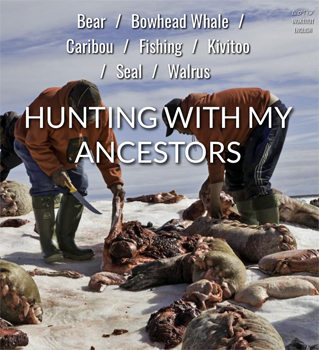
Butchered walrus is packaged in large bags made of the
animal’s hide, then buried to ferment before being eaten.
Uncredited photo from Hunting With My Ancestors.
Hunting With My Ancestors:
A seven-part documentary by Kingulliit Production’s Zacharias Kunuk
reviewed by Sue Hamilton
Episode 1: Bowhead Whale (Aqvik) HuntKingulliit (read this word’s meaning here) Productions is an Inuit-owned multimedia production company based in Igloolik, Nunavut, founded in 2010 by Zacharias Kunuk and Norman Cohn. Kingulliit updates and replaces Igloolik Isuma Productions and continues the tradition for producing independent Inuktitut-language films and TV from the Inuit point of view, while recognizing the importance of new media and innovative technologies to the future of communications in the north in the 21st century. For more information: email or phone 1-867-934-8725. (description taken from the Isuma.TV website)
Viewers will watch the planning, preparation, hunting, killing, harvesting, the celebrations and eating; voting who would be the captain of all the boats, who would launch the first harpoon spears, who would use the grenade harpoon.
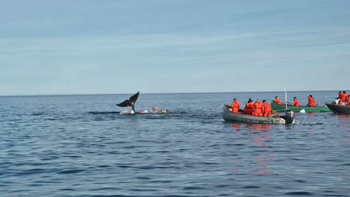
Uncredited photo from Hunting With My Ancestors.
All the safety suits and electronic communication devices, boats and motors and heavy equipment to haul the carcass out of the water are compared to how bowheads were hunted in skin boats and with stone tools.
The film is forty-nine minutes and also offers bonus material of stills and short videos on all aspects of the hunt including the significance of the hunt to the community.
Episode 2: Net Fishing (Iqalugasuk) Under the Ice
The men in this episode were fishing in the deep cold of a dark December out of a need for food and to continue in the tradition of their ancestors. They used co-op bought nets, lines and ice chisels. They traveled by snow machine and had white gas stoves to heat their tea. Can you imagine what it was like before these items could be store bought?
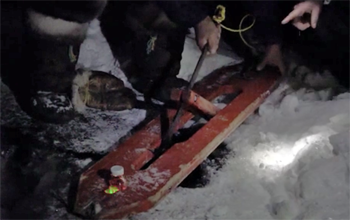
This wooden ice jigger is ready to be put down a hole chopped in the sea ice.
Note glowing green light in a white-capped ketchup bottle in the front.
Screen capture from Hunting With My Ancestors.
Perhaps they built their own ice fish jigger, an ingenious invention that is shoved into the chopped out hole and “walks”, by means of a pulley system, floating along the underside of the ice to another hole at a distance. A flashing light sealed inside an empty ketchup bottle attached to the jigger makes the travel direction visible through the ice.
This thirty-minute film has bonus material: production stills, community feasting, women making brooms out of ptarmigan feathers, pages from an old (unidentified) book with text and photos of fishing.
Episode 3: Dog Team Bear (Nanuq) Hunt
Zacharias Kunuk begins by referencing the 1950-1975 killing of dogs, then describes the inception of the Nunavut Quest, “The people of Arctic Bay thought to revive dog teaming for the youth using the Inuit dogs and knowledge.” He goes on to describe the use of dog teams in modern times as an introduction to this video about an adult and his son on their very first bear hunt by dog team, with a novice team being trained to hunt bears.
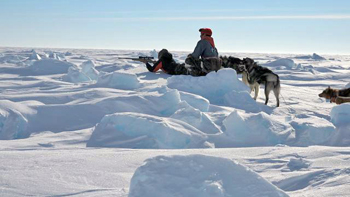
A young hunter is about to take a shot at his first polar bear.
Uncredited photo from Hunting With My Ancestors.
Elders traveled along in the Igloolik region by snow machine. The narrator is the hunter who describes his feelings and emotions. It is his fourteen year-old son who actually shoots the nine-foot bear. In the following scenes Elders advise on how the bear is to be skinned before it is butchered.
The extras in this thirty-minute episode include production stills, several videos showing how to skin a bear and then how to clean the skin and four archival prints of bear hunting, two by Inuit and two by qallunaat (outsiders) explorers.
Episode 4: Kivitoo – What they thought of us? (Kivitoo)
In 1963 three Inuit men traveling to Qikiqtarjuaq from Kivitoo (thirty-one miles to the north on the coast of Baffin Island in what is now Nunavut) to pick up supplies were never heard from again. Days later, the People of this settlement learned from qallunaat that the men were found frozen and were buried before informing and consulting worried, now grieving, relatives and friends. Very shortly thereafter, the government arrived and told the People they were to be flown to Qikiqtarjuaq. The flight happened so quickly, there was neither time to grieve nor time to pack up and take along all their belongings. The inhabitants, told they would be returning soon, felt they would be coming back to the rest of their possessions.
The following spring residents of Kivitoo returned to find their settlement burned to the ground, bulldozed and buried…everything gone.
This video is tragic beyond belief and it deserves your attention. Many people are interviewed. Kivitoo was described as a good place to live with an abundance of wildlife. “It was a happy time to be on dog teams and go hunting.” Kunuk’s camera captures the emotional aftermath, as fresh as at the time of the 1963 relocation. Tears freely flowed while Elders recounted memories as some of what the government had bulldozed decades before was dug up by former residents’ hand shoveling. Many cherished and useful items – qulliq (oil lamp), a harpoon, firearms, clothing – now rusted relics were laid out on the ground.
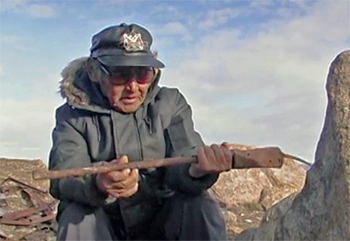 "This was my rifle and I was proud of it…I prized it very highly… it was important to me.” |
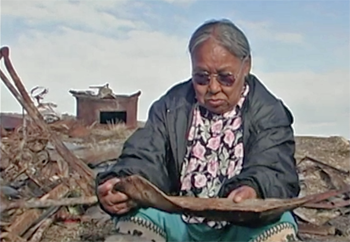 “This qulliq was my seal oil lamp…It dried wet things, it heated the sod house.” |
Screen captures from Hunting
With My Ancestors.
“It was heartbreaking to see my old things. Even my father’s
brand new rifle was destroyed.” “This was part of
assimilation.” “We still yearn to go home. The feeling
doesn’t go away.” “We are still homesick for this place.” As with the other episodes, the Inuktitut dialog is translated into English. The forty-three-minute video begins with a song, which is refrained throughout. In part…
I want my family to know this.
We witness hardship.
We were thrown out from our homeland.
We left in tears.
We witness hardship.
We were thrown out from our homeland.
We left in tears.
Episode 5: Walrus (Aiviq) Hunt
At the beginning of this episode, it is February in Igloolik. Hunters are seen heading out on their snow machines towing qamutiit, traveling in a blizzard over very rough ice to the floe edge. Abruptly, the scene shifts to July where boats are heading out of town, wending their way through summer ice floes, at one point hauling the boat onto the sea ice and then over to open water in search of walrus.
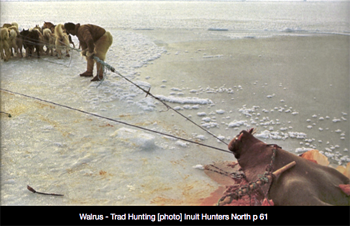
Uncredited archival photo from Hunting With My Ancestors.
A walrus is shot, then harpooned. It is fascinating to see hunters stepping onto a very small and shallow ice floe and use a pulley system to drag the huge animal onto the floe where both the meat and the guts are butchered and tossed into the boat for the ride back to Igloolik. Bite-sized pieces of meat are eaten and very much enjoyed. This is all such incredibly hard work. Imagine what it was like hunting walrus thousands of years ago!
In addition to the production stills and images of text with photos, there are four videos showing the finishing of building a qamutiik. Also, in a thirty-two minute video extra, an Elder explains the proper places to shoot a walrus. He explains how to butcher it and how to identify a sick one by its behavior. Meat is stored in pouches fashioned from the animal’s own skin, then the proper way to cache the meat is described. I understand that for some igunaq is an acquired taste.
Episode 6: Seal (Nattiq) Pup Hunt
In June 2017, Elder Louis Uttak teaches a group of youths how to hunt ring seal pups. Accompanied by a support team, all are traveling by snow machines pulling qamutiit, some with fitted small plywood shelters atop. They are out on the ice searching for breathing holes. The location is at an abandoned settlement known as Siurajuk, on Baffin Island, 31 to 37 miles east of Igloolik, itself on a small island off the northeast coast of the Melville Peninsula in Nunavut. The students gather around their teacher as he explains how to find the holes, how to quietly stand over them waiting for a seal to reveal itself, how to hold and throw the harpoon, how to skin and butcher.
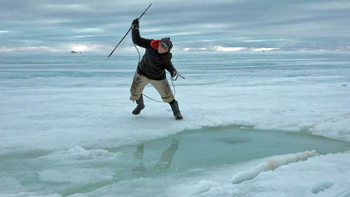
After a long wait, a
young hunter senses a seal is about to surface.
Uncredited photo #110 from Hunting With My Ancestors.
When not working with the students, Uttak reminisces as he
and others walk amongst the remains of the 1956 tent rings
and found items.Uncredited photo #110 from Hunting With My Ancestors.
In this fifty-five minute video there are long, long stretches of no dialogue at all, just scene after scene after scene of novice hunters standing over holes, waiting to see movement in the water indicating a seal is about to surface. If we viewers, sitting comfortably in a warm house, grow impatient waiting for some real action, just imagine how it was for these hunters spending hours waiting for success that may or may not come.
It is very informative to listen to Elder Uttak impart his wisdom to his audience. My only regret is that this seal hunting event was done entirely without the assistance of dogs or even any reference to their use.
The extras in this segment include many still images of hunting and processing carcasses, a video of skinning a large bearded seal (be sure to note how this is done because this is the way used when making those very, very long one-piece seal skin tug lines) as compared to skinning a ring seal; other videos of women skinning seals and processing the hides; a wonderful four-part interview with Elder Uttak about his past life; stills of text and images entitled “research” about bearded seals.
Episode 7: Caribou (Tuktu) Hunt With Peter Suwaksiork
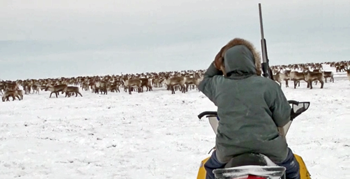
Peter Suwaksiork prepares to harvest a caribou.
Screen capture from Hunting With My Ancestors.
“Back then dogs would have a spiritual helper. Their hind legs would be shaking when they were getting ready to go. And when they took off, it would just be a cloud of snow. By using proper equipment, the lead dogs would run faster.”Because the abundance of spoken dialogue is Inuktitut, I had to choose between the traveling, hunting skinning and butchering visuals or the English subtitles. It is well worth watching this exceptional offering twice, to catch the action the second time around.
In addition to the usual production still extras, there are two short videos showing hunting, skinning and butchering. Also, there are three videos demonstrating the physically demanding work of processing caribou hides. Additionally there are pages taken from books, some from Rasmussen’s Across Arctic America with text and images about caribou.
Ed: The importance of Zachariah Kunuk’s Hunting With My Ancestors capturing and preserving the knowledge and experiences of Inuit Elders cannot possibly be overstated! These teachable moments are now available for you to enjoy for free on the Isuma.tv multimedia site.